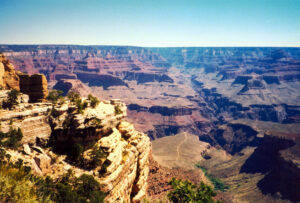
| Objective: Backpacking to Colorado River, Grand Canyon National Park, Arizona, USA Distance: 28.5 miles (loop) Elevation Gain: -4,780′ (descent to canyon floor), 4,380′ (ascent to South Rim) Trip Length: 3 days Terrain: Canyon, river, waterfall Best time to visit: April, May, October Caution: Heat, dehydration |
Don’t just stand at the edge like everyone else. Grab a pack and hike from the South Rim to the canyon floor of the Grand Canyon. Spend a couple days exploring the Colorado River and then climb out again. Every step you take transports you to another era of the Earth’s vast geological timescale. This mighty river carved a colossal rift, revealing the story of past eons painted as colorful stripes on canyon walls.
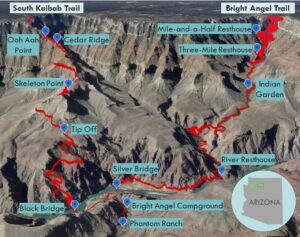
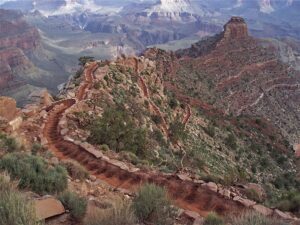
Descent from the South Rim to the Colorado River
| Distance: 7 miles (one-way) Elevation Loss: 4,780′ from South Rim to canyon floor |
This is the rim to canyon segment of the trip. In the morning, you will start at the top of the South Rim. Tonight, you will camp at Bright Angel Campground. Prepare your knees!
From the Yaki Point trailhead, the South Kaibab Trail descends ridgelines and ravines. The trail has a steep set of tight north facing, knee busting switchbacks, and practically no shade. You descend a west-facing slope to Coconino Sandstone and Ooh Ah Point. From here, the trail shifts to Cedar Ridge, descending on its east and west sides. Watch out for the sure-footed mule trains. They need a wide berth to avoid tumbling over the edge.
From Cedar Ridge, the trail shoots straight below O’Neill Butte all the way to Skeleton Point. The trail walks right off the plank at Skeleton Point and tumbles down steep switchbacks dynamited from the limestone. The erosion is more pronounced the closer you are to the river. The fractured river bank becomes crumblier and filled with jagged crags once you descend below the sandstone of Tonto Platform. The Grand Canyon is a never-ending fractal. The curlicue terrain at the bottom resembles the overall shape of the canyon as seen from the sky.

The Vishnu Basement Rocks form the oldest layer along the river’s edge deposited 1.8 million years ago. Above the Colorado River, cross the steel Black Bridge to Bright Angel Campground. Before setting up camp, take a well-deserved break and dip your toes in the icy cold Bright Angel Creek. Phantom Ranch consists of log cabins where you can find snacks.
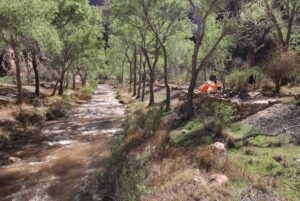
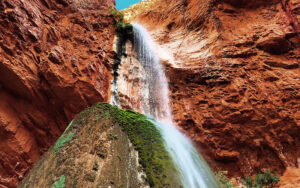
Ribbon Falls
| Distance: 12 miles (round-trip) Elevation Gain : 1,260′ from the canyon floor (2,480′) to Ribbon Falls (3,740′) |
From Phantom Ranch, the North Kaibab Trail follows the Bright Angel Creek into the Inner Gorge. This narrow canyon is essentially an oven during midday. After criss-crossing the creek, you reach a point where you turn toward the waterfall. The path climbs up and down Asinine Hill, and crosses a bridge. Ribbon Falls is located in a grotto on the west side of Bright Angel Creek. Within all this red rock is a sliver of water, which paints a green mossy stripe.
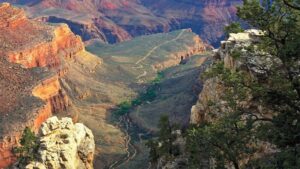
Ascent to the South Rim
| Distance: 9.5 miles (one-way) Elevation Gain: 4,380′ from canyon floor (2,480′) to South Rim (6,860′) |
This is the canyon to rim segment of the trip. In the morning, you will start at Bright Angel Campground. Today, you will return the top of the South Rim.
The Bright Angel Trail follows a rift formed by the Bright Angel Fault. From Bright Angel Campground to River Resthouse, the trail passes sand dunes until the Silver Bridge crosses the Colorado. The trail rises at the Devil’s Corkscrew where a gully drains into Pipe Creek. The little crooks in the red walls of the canyon shelter young cottonwood trees providing ample shade and contrasting colors. If you are lucky, you may spot a Bighorn sheep in one of these jagged gully nooks.
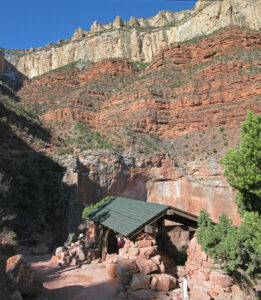
From the oasis of Indian Garden, the real work begins via a stretch of tough switchbacks. The resthouses and water sources are welcome refuges during the steep climb to the top. The trail has massive vermilion walls and orange cliffs providing shade and water for plants and animals. Celebrate atop the South Rim after you have finally emerged from the scorching and infernal depths.
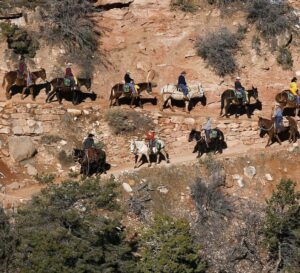
Directions to Trailhead
| Take the 40 E to Williams and use exit 165 for AZ-64 N. Drive 54.9 miles and turn left at Center Drive. Continue 1.6 miles to Village Loop Drive. Park at the Backcountry Information Center (Lot D), and walk 5 minutes or park at the Visitor Center. Then, take the free shuttle bus (20 minutes). The South Kaibab trailhead is near Yaki Point. |
Red Tape
Get a permit for overnight camping. Follow the procedures for submitting a permit request via fax or mail: https://www.nps.gov/grca/planyourvisit/backcountry-permit.htm
Video Tour of Grand Canyon Rim to River Hike
If you have some extra time while you are in the area, consider backpacking to Havasu Falls.